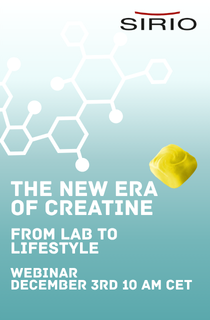Fabulous fiber: Industry roundtable on enhancing brain-gut health and upcoming trends
13 Oct 2022 --- It is commonly known that what one eats affects one’s digestive and overall health. Within this space, NutritionInsight explores the role of fiber in supporting a healthier life with key experts from Alland & Robert, Sensus, Beneo and ADM. We investigate how dietary fibers play a role in healthy digestion and decrease risks of cardiovascular diseases and cancer, and spotlight the trends to look out for in this market.
“The gut microbiome interacts heavily with other organs in the human body like the brain, liver, kidneys and muscles. Therefore, nutrition beneficial to the gut and its microbiome is key to a person’s long-term health,” says Anke Sentko, regulatory affairs and nutrition communication VP at Beneo.

“Dietary fibers are part of a healthy, well-balanced diet and contribute to good digestion and increased satiety. They keep the gastrointestinal tract healthy as they feed the microbiota. They have also been associated with a decreased risk for cardiovascular diseases, type 2 diabetes and colon cancer,” adds Veerle Dam, health science and regulatory affairs specialist at Sensus.
Meanwhile, Dr. Isabelle Jaouen, R&D director at Alland & Robert, explains that fibers are “essential” due to their contribution to digestive health, as the gastrointestinal system has been linked to numerous aspects such as digestion, weight management, immunity, chronic illnesses, sleep and skin health.
“Consumers today are proactively looking for foods and beverages that can support their holistic health and wellness, and many of these consumers are increasingly aware of the connection between their gut and their overall well-being,” shares Deanne Dick, director of fiber at ADM.Chicory root field (Credit: Beneo).
Prebiotic and fiber types
Sentko at Beneo suggests chicory root fibers (inulin, oligofructose) as a plant-based prebiotic source, which has been scientifically proven to improve the gut environment, combating pathogens and strengthening the gut barrier function.
“A recent study has shown that prebiotic chicory root fiber intake (starting at 3 g/day) promotes significant growth of Bifidobacteria in the gut microbiome in all age groups and improves bowel function parameters.”
“Acacia gum, for example, is a prebiotic fiber. Several studies have shown its positive effect on the microbiome and how it helps the growth of beneficial bacteria in the gut. It is also used in formulation to lower the glycemic index of food products,” adds Jaouen at Alland & Robert.
Alland & Robert studied the benefits of acacia gum on gut health through a large consumer study in 2021, finding that it improves global digestive wellness and relieves the symptoms of intestinal discomfort.
“Dietary fiber, particularly soluble dietary fiber like chicory inulin and oligofructose, are fermented by the good gut microbiota who increase in number while doing so. Therefore, chicory inulin and oligofructose contribute to a healthy gut,” says Dam at Sensus.
“However, health-related support by dietary fiber depends on the type of fiber. Although various types of fiber exist in fruit, vegetables, nuts, brans and cereals, such as cellulose, hemicellulose, ß-glucans, pectins and fructans, not all of them share the same technical or nutritional benefits,” continues Sentko.
She also explains that the differences in fiber properties are influenceable by solubility, viscosity and fermentability. “As preferred nutrients for helpful bacteria in the gut, inulin and oligofructose – dietary fibers and prebiotics – have been scientifically shown to promote health. For example, they support regularity, lowering glycaemic responses after food intake.”
Awareness and fibers
Jaouen at Alland & Robert highlights that knowledge is power, and the growing awareness around prebiotics and probiotics is allowing consumers to better understand how their bodies work, and the importance of taking care of their digestive health.
“Some of the priorities of the brands include educating consumers and helping them make good choices to gain control of their health. This is particularly visible in fiber-enriched and functional products, where the benefits of fibers are well displayed,” she continues.
“In addition, consumers are increasingly linking their health with the planet’s health, and brands must provide more and more transparency about their climate-friendly and ethical commitments.”
Moreover, Jaouen expects the fiber demand to rise due to the FDA’s recent approval of acacia gum as a dietary fiber, increasing customers’ interest in Acacia Fibre. “Acacia gum can now be classified as a fiber for nutrition labeling purposes in the US,” she says.  Anke Sentko, regulatory affairs and nutrition communication VP at Beneo.
Anke Sentko, regulatory affairs and nutrition communication VP at Beneo.
“Also, the FDA decision will have an impact beyond the US as many countries apply US Food and Health Authority guidelines in their local markets. It also confirms the benefits of acacia gum on human health.”
Formats and mental health
With this heightened focus, there is a great opportunity for gummy, tablet and stick pack manufacturers to increase fiber content and meet consumer demands today and tomorrow, says Dick at ADM.
“Interestingly, many consumers who have made changes to their diets and lifestyles because they are aware of the gut microbiome have increased fiber intake,” she points out.
“Consumers also seek fiber for additional wellness attributes, such as weight management, satiety and reducing blood sugar spikes.”
Apart from digestive health, Dam shares that Sensus closely follows the increasing attention to mental health.
“Recently, interest has grown in communication between our gut, the microbiota that lives in it, and the brain. A growing number of research studies suggest that a healthy microbiome can positively influence mental health like mood, sleep, or cognition,” she continues.
Functional food and drinks
Sentko at Beneo outlines that consumers are seeking out food and drink products to improve health issues.
“As gut health moves from the sidelines into the mainstream, the future of products supporting digestive health looks strong. The key to success, however, lies in the ability of producers to deliver fiber-enriched foods in palatable and more enjoyable ways in less expected categories such as confectionery or yogurt.”
Dick adds that consumers are interested in customized foods and beverages to meet individual needs.
“Certain formats in this category lend themselves to greater fiber incorporation, such as yogurt drinks, shakes, kefir beverages and kombuchas. We also foresee functional energy drinks, sparkling waters and carbonated soft drinks featuring fiber inclusion to make an even bigger market splash,” she explains.
“Beverages overall are ripe for growth in the gut health arena, as they provide convenient vehicles to help consumers easily obtain functional attributes throughout their daily routines while also providing an enjoyable experience.”
Primary consumers
Eating is vital to health, no matter the age. However, Sentko at Beneo observes that the demand is growing for people aged over 60 for health-based dietary solutions.Dr. Isabelle Jaouen, R&D director at Alland & Robert.
“We are seeing increasing demand for healthy aging recipe formulations as more people want to control their health into later life. Our recent research with Health Focus International has highlighted that 85% of those aged 50 and older have shown a willingness to take charge of their health, realizing that their short-term health depends on how well they take care of themselves,” she says.
“We see that consumers become more and more health-conscious and are increasingly aware that food plays an important role in their health. Consumers want to choose products that taste good and are nutritious simultaneously,” adds Dam at Sensus.
“Chicory inulin and oligofructose are prebiotic fibers that can also be used to replace sugar and fat. Therefore, adding inulin or oligofructose to your products can meet consumers’ demands for healthy and tasty food.”
Susceptibility to poor fiber consumption
Meanwhile, Jaouen at Alland & Robert shares that busy, modern lifestyles can make it harder to prepare high-fiber meals.
“Yet poor fiber consumption is associated with higher risks of diabetes, heart disease and other chronic diseases. In addition, millions of people worldwide are affected by digestion discomforts. Eating a high-fiber diet can help solve some of their health issues. Education is key to encouraging people to eat healthier diets and take good care of their bodies,” she suggests as a solution.
“The UK’s Scientific Advisory Committee on Nutrition recommends that adults eat 30 g of fiber daily. However, figures from the National Diet and Nutrition Survey show that UK adults are eating approximately 20 g of fiber on average,” shares Sentko.
She suggests that the “fiber gap” can be resolved by eating foods rich with chicory root fibers or helping consumers choose to consume more fiber with clear on-pack messaging.
“In a recent consumer survey that Sensus conducted in the US, two out of three consumers state that fiber intake is important for their gut health. However, 79% of the consumers did not know what the recommended daily fiber intake is,” adds Dam.
“In a recent collaboration project with Wageningen University and the Dutch Digestive Foundation, amongst others, data showed a significant fiber dip on weekend days compared with weekdays in a Dutch study population. Therefore, education and increasing fiber in indulgence products eaten more often on weekends might help increase the fiber intake.”Deanne Dick at ADM says that consumers are proactively looking for F&B that can support their holistic health.
Noteworthy products
In the dietary fiber product space, Jaouen highlights that Acacia Fibre by Alland & Robert offers a minimum of 90% fiber content.
“Highly soluble in water, acacia gum is very low in calories and very slowly fermented, which means a minimal evolution of the fiber content, a great digestibility and tolerance. This range meets the needs of people with IBS (Irritable Bowel Syndrome or sensitivity to FODMAP.”
“Orafti Inulin and Oligofructose are scientifically proven to support digestive health and comply with the International Scientific Association for Probiotics and Prebiotics definition of prebiotics. Over the past ten years, research demonstrates the various directions of health support offered by prebiotic chicory root fibers,” shares Sentko at Beneo.
Moreover, Sensus also sells inulin and oligofructose plant-based fibers from the chicory root. “Our inulin and oligofructose are versatile ingredients used in various applications like dairy, bakery and confectionery, improving taste and texture while reducing sugar and fat content and adding prebiotic fiber,” says Dam.
“ADM and Matsutani created Fibersol, a soluble dietary fiber. Fibersol provides added fiber and builds back integrity through structural and binding qualities that can be lost in the absence of sugar,” she concludes.
By Venya Patel
















